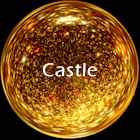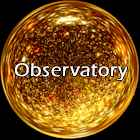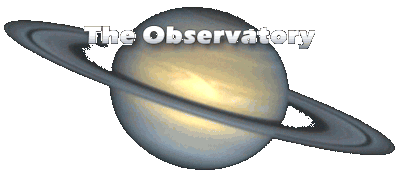
Introducing the Night Sky
Part 4
by John Harper
![]()
There is one more celestial object which I should describe before we return to the stars, and that is the moon, which waxes and wanes from crescent to full and back to a crescent again within the period of a month. Actually, the average time between two consecutive full moons is 29 days, 12 hours, 44 mins, 2.9 secs. The various appearances of the moon, the shape it appears to be in the night sky, are called phases. The phases of the moon are caused by the angle at which sunlight falls on the moon, and also where the moon happens to be in relation to the earth at the time.
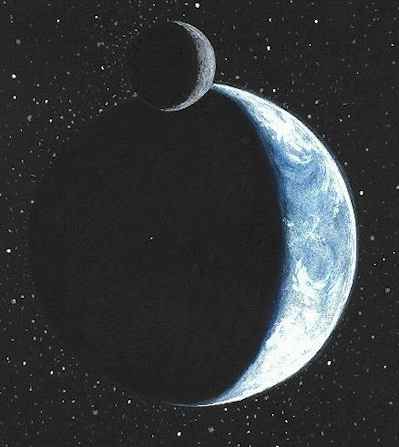
Earth and Moon
(Painting by John Harper)
At new moon, both moon and sun are in the same part of the sky, and as a result, the night side of the moon is facing us. At this time, the moon cannot be seen at all - it is lost in the sun's glare. Within the week following new moon, the thin crescent begins to appear in the western twilight and after sunset. At this time it is possible to see a most beautiful phenomenon called 'Earthshine', faintly illuminating the rest of the moon's disc. What we are seeing is the light of ourown planet reflected from the lunar night surface, rather like the full moonilluminating the landscape on earth at night. In days gone by, this beautiful sight was often referred to as 'The old moon in the new moon's arms.'
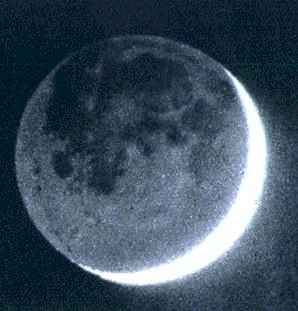
Earthshine
"The old moon in the new moon's arms"
Seven days or so after new moon, the moon looks like a capital letter 'D' in the sky - it is now at first quarter, and it has covered a quarter of its orbit of the earth. This is an ideal time to see the craters through binoculars. Notice how they are best seen near the straight edge, or Terminator, as it is properly called. The Terminator is the line of lunar sunrise at this time, and the craters are easy to see because they are filled with deep shadows cast by the low rising sun.
Most lunar craters are believed to have been produced when the moon was bombarded by thousands of lumps of rock in the early days of the solar system, some 4 000 million years ago. They are the circular depressions covering much of the lunar surface. The largest crater on the earth-facing hemisphere of the moon lies near the southern edge or 'limb' of the moon, and is called Bailley, a crater over 180 miles (300km) in diameter.
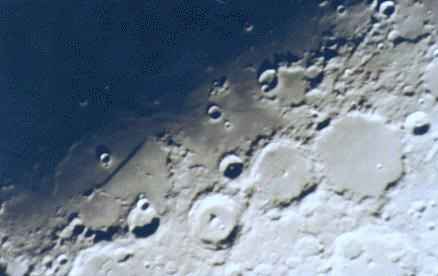
Craters on the Moon
(Photograph by J. Harper)
During the next week, the moon becomes gibbous or three quarter in shape, until, a fortnight after new moon, the moon becomes full. Our satellite is now opposite the sun in the sky, and has accomplished half of its orbit around the earth. Full moon is the best time to see the lunar Maria, or seas. These are the relatively dark smooth planes once thought to contain water, but which are in reality, vast lava flows filling huge impact basins of the distant past. It is these dark areas that in our mind's eye we see as the 'man in the moon' and other fanciful figures, such as the Lady, the Crab, the Hare, and even the Poodle, in the moon!
The Full Moon
A week later, the moon has waned to last quarter, when it is about to start the last quarter of its orbit of earth. It now looks like a reversed capital D. Seven days after this, the moon is new again, and lost once more in sunlight, ready to recommence its cycle of phases all over again.
Occasionally at new moon, when the earth, moon and sun line up exactly in that order, we can witness the awe-inspiring spectacle of a total eclipse of the sun. At this time, the moon's shadow falls on the earth, and in the cone of the shadow everything becomes cold and dark as the moon covers the sun's disc, cutting off the light and heat for several minutes.
A total eclipse of the sun
When the sun, earth and moon line up exactly at the time of full moon, we can observe an eclipse of the moon. On this occasion we watch the moon pass into the earth's shadow. The moon often becomes dim and russet coloured, and can look most strange during a lunar eclipse. The colour effect is due to sunlight being refracted (bent) through earth's atmosphere onto the moon.
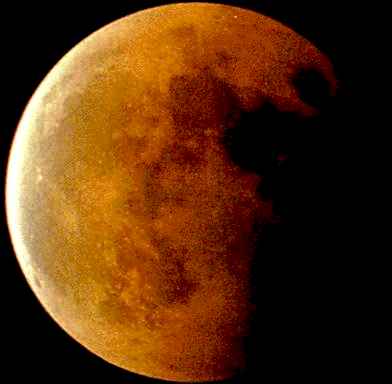
Total eclipse of the moon
![]()
Written by John Harper for Diarmid's Observatory
